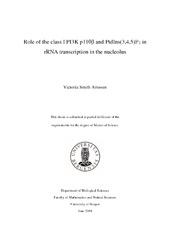| dc.description.abstract | The phosphoinositide 3-kinase (PI3K) signalling pathway is one of the most altered pathways in human cancer. It is a complex pathway, when considering that ubiquitously expressed isoforms regulate different routes with their own cellular outcomes. The majority of research has been focused on the PI3K p110α isoform, due to frequent findings of mutations in different human cancers. The PI3K p110β isoform has received less attention, however it has been found to be tumorigenic when overexpressed in its wild-type form, which has been linked to its lipid kinase activity. Our group has focused on p110β and shown that the mRNA for the p110βcoding gene PIK3CB are elevated in endometrial cancer cell lines. Also, our group has demonstrated that the nuclear levels of PtdIns(3,4,5)P3 (PIP3), the lipid product of p110β, is high in the endometrial cancer cell line RL95-2. Both p110β and PIP3 have been found to localise in the nucleus and nucleolus of some cell lines, though their role in the nucleolus is still unknown. During this study, p110β and its lipid product PIP3 was confirmed to localise within the nucleoli of RL95-2 cells. To determine what the purpose of p110β and PIP3 is within nucleoli and ribosomal biogenesis, p110β was inhibited by Kin193, a specific p110β inhibitor. The results show a decrease in 47S rRNA transcription, the initial ribosomal transcript. Labelling nascent rRNA with and without Kin193 showed that inhibiting p110β indeed led to decreased rRNA fluorescent signal in human cells. These findings further validate Kin193 as a potential anti-cancer drug in patients with endometrial cancer. The experiments were also performed on two mouse cell lines, one p110β wild type (WT) and a p110β catalytic mutant (KI), though there were no significant differences between them. For PIP3 to function as a signalling lipid, it must bind and recruit proteins. During a PIP3 lipid pull-down from the nuclei of HeLa cells, our group found a cohort of potential PIP3 effector proteins. One of these was poly(ADP-ribose) polymerase I (PARP1), which is involved in single stranded DNA break repair, amongst other roles. PARP1 has also been found to localise in the nucleolus, along with PIP3, and PTEN-deficient endometrial cancer cells have been shown to be sensitised to PARP1 inhibition. PARP1 contains multiple KR-motifs, which are known to bind PIP3. The results show that fragments 1, 2 and 3 bind a variety of lipids, including PIP3. Fragment 3, which contains a KR-motif, was also analysed in NMR spectroscopy, where the KR-motif was confirmed to be part of PIP3 interaction. | en_US |
